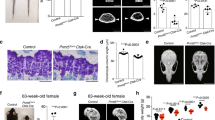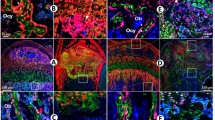Abstract
Longitudinal bone growth progresses by continuous bone replacement of epiphyseal cartilaginous tissue, known as “growth plate”, produced by columnar proliferated- and differentiated-epiphyseal chondrocytes. The endochondral ossification process at the growth plate is governed by paracrine signals secreted from terminally differentiated chondrocytes (hypertrophic chondrocytes), and hedgehog signaling is one of the best known regulatory signaling pathways in this process. Here, to investigate the developmental relationship between longitudinal endochondral bone formation and osteogenic progenitors under the influence of hedgehog signaling at the growth plate, genetic lineage tracing was carried out with the use of Gli1CreERT2 mice line to follow the fate of hedgehog-signal-responsive cells during endochondral bone formation. Gli1CreERT2 genetically labeled cells are detected in hypertrophic chondrocytes and osteo-progenitors at the chondro-osseous junction (COJ); these progeny then commit to the osteogenic lineage in periosteum, trabecular and cortical bone along the developing longitudinal axis. Furthermore, in ageing bone, where longitudinal bone growth ceases, hedgehog-signal responsiveness and its implication in osteogenic lineage commitment is significantly weakened. These results show, for the first time, evidence of the developmental contribution of endochondral progenitors under the influence of epiphyseal chondrocyte-derived secretory signals in longitudinally growing bone. This study provides a precise outline for assessing the skeletal lineage commitment of osteo-progenitors in response to growth-plate-derived regulatory signals during endochondral bone formation.





Similar content being viewed by others
References
Ahn S, Joyner AL (2004) Dynamic changes in the response of cells to positive hedgehog signaling during mouse limb patterning. Cell 118(4):505–516. https://doi.org/10.1016/j.cell.2004.07.023
Alcedo J, Noll M (1997) Hedgehog and its patched-smoothened receptor complex: a novel signalling mechanism at the cell surface. Biol Chem 378(7):583–590
Bitgood MJ, McMahon AP (1995) Hedgehog and Bmp genes are coexpressed at many diverse sites of cell-cell interaction in the mouse embryo. Dev Biol 172(1):126–138. https://doi.org/10.1006/dbio.1995.0010
Borjesson AE, Lagerquist MK, Liu C, Shao R, Windahl SH, Karlsson C, Sjogren K, Moverare-Skrtic S, Antal MC, Krust A, Mohan S, Chambon P, Savendahl L, Ohlsson C (2010) The role of estrogen receptor alpha in growth plate cartilage for longitudinal bone growth. J Bone Miner Res 25(12):2690–2700. https://doi.org/10.1002/jbmr.156
Borjesson AE, Lagerquist MK, Windahl SH, Ohlsson C (2013) The role of estrogen receptor alpha in the regulation of bone and growth plate cartilage. Cell Mol Life Sci 70(21):4023–4037. https://doi.org/10.1007/s00018-013-1317-1
Breur GJ, VanEnkevort BA, Farnum CE, Wilsman NJ (1991) Linear relationship between the volume of hypertrophic chondrocytes and the rate of longitudinal bone growth in growth plates. J Orthop Res 9(3):348–359. https://doi.org/10.1002/jor.1100090306
Chuang PT, McMahon AP (1999) Vertebrate Hedgehog signalling modulated by induction of a Hedgehog-binding protein. Nature 397(6720):617–621. https://doi.org/10.1038/17611
Farnum CE, Lee R, O’Hara K, Urban JP (2002) Volume increase in growth plate chondrocytes during hypertrophy: the contribution of organic osmolytes. Bone 30(4):574–581
Furuyama K, Kawaguchi Y, Akiyama H, Horiguchi M, Kodama S, Kuhara T, Hosokawa S, Elbahrawy A, Soeda T, Koizumi M, Masui T, Kawaguchi M, Takaori K, Doi R, Nishi E, Kakinoki R, Deng JM, Behringer RR, Nakamura T, Uemoto S (2011) Continuous cell supply from a Sox9-expressing progenitor zone in adult liver, exocrine pancreas and intestine. Nat Genet 43(1):34–41. https://doi.org/10.1038/ng.722
Gerber HP, Vu TH, Ryan AM, Kowalski J, Werb Z, Ferrara N (1999) VEGF couples hypertrophic cartilage remodeling, ossification and angiogenesis during endochondral bone formation. Nat Med 5(6):623–628. https://doi.org/10.1038/9467
Golovchenko S, Hattori T, Hartmann C, Gebhardt M, Gebhard S, Hess A, Pausch F, Schlund B, von der Mark K (2013) Deletion of beta catenin in hypertrophic growth plate chondrocytes impairs trabecular bone formation. Bone 55(1):102–112. https://doi.org/10.1016/j.bone.2013.03.019
Haraguchi R, Motoyama J, Sasaki H, Satoh Y, Miyagawa S, Nakagata N, Moon A, Yamada G (2007) Molecular analysis of coordinated bladder and urogenital organ formation by hedgehog signaling. Development 134(3):525–533. https://doi.org/10.1242/dev.02736
Haraguchi R, Matsumaru D, Nakagata N, Miyagawa S, Suzuki K, Kitazawa S, Yamada G (2012) The hedgehog signal induced modulation of bone morphogenetic protein signaling: an essential signaling relay for urinary tract morphogenesis. PLoS One 7(7):e42245. https://doi.org/10.1371/journal.pone.0042245
Haraguchi R, Kitazawa R, Mori K, Tachibana R, Kiyonari H, Imai Y, Abe T, Kitazawa S (2016) sFRP4-dependent Wnt signal modulation is critical for bone remodeling during postnatal development and age-related bone loss. Sci Rep 6:25198. https://doi.org/10.1038/srep25198
Haraguchi R, Kitazawa R, Murashima A, Yamada G, Kitazawa S (2017) Developmental contribution of wnt-signal-responsive cells to mouse reproductive tract formation. Acta Histochem Cytochem 50(4):127–133. https://doi.org/10.1267/ahc.17017
Hasty P, Vijg J (2004) Accelerating aging by mouse reverse genetics: a rational approach to understanding longevity. Aging Cell 3(2):55–65. https://doi.org/10.1111/j.1474-9728.2004.00082.x
Hellemans J, Coucke PJ, Giedion A, De Paepe A, Kramer P, Beemer F, Mortier GR (2003) Homozygous mutations in IHH cause acrocapitofemoral dysplasia, an autosomal recessive disorder with cone-shaped epiphyses in hands and hips. Am J Hum Genet 72(4):1040–1046
Karimian E, Chagin AS, Savendahl L (2011) Genetic regulation of the growth plate. Front Endocrinol (Lausanne) 2:113. https://doi.org/10.3389/fendo.2011.00113
Kilborn SH, Trudel G, Uhthoff H (2002) Review of growth plate closure compared with age at sexual maturity and lifespan in laboratory animals. Contemp Top Lab Anim Sci 41(5):21–26
Kindblom JM, Nilsson O, Hurme T, Ohlsson C, Savendahl L (2002) Expression and localization of Indian hedgehog (Ihh) and parathyroid hormone related protein (PTHrP) in the human growth plate during pubertal development. J Endocrinol 174(2):R1-6
Kojima T, Hasegawa T, de Freitas PH, Yamamoto T, Sasaki M, Horiuchi K, Hongo H, Yamada T, Sakagami N, Saito N, Yoshizawa M, Kobayashi T, Maeda T, Saito C, Amizuka N (2013) Histochemical aspects of the vascular invasion at the erosion zone of the epiphyseal cartilage in MMP-9-deficient mice. Biomed Res 34(3):119–128
Kretzschmar K, Watt FM (2012) Lineage tracing. Cell 148(1–2):33–45. https://doi.org/10.1016/j.cell.2012.01.002
Kronenberg HM (2003) Developmental regulation of the growth plate. Nature 423(6937):332–336. https://doi.org/10.1038/nature01657
Maeda Y, Nakamura E, Nguyen MT, Suva LJ, Swain FL, Razzaque MS, Mackem S, Lanske B (2007) Indian Hedgehog produced by postnatal chondrocytes is essential for maintaining a growth plate and trabecular bone. Proc Natl Acad Sci USA 104(15):6382–6387. https://doi.org/10.1073/pnas.0608449104
Maeda Y, Schipani E, Densmore MJ, Lanske B (2010) Partial rescue of postnatal growth plate abnormalities in Ihh mutants by expression of a constitutively active PTH/PTHrP receptor. Bone 46(2):472–478. https://doi.org/10.1016/j.bone.2009.09.009
Mak KK, Bi Y, Wan C, Chuang PT, Clemens T, Young M, Yang Y (2008) Hedgehog signaling in mature osteoblasts regulates bone formation and resorption by controlling PTHrP and RANKL expression. Dev Cell 14(5):674–688. https://doi.org/10.1016/j.devcel.2008.02.003
Makela EA, Vainionpaa S, Vihtonen K, Mero M, Rokkanen P (1988) The effect of trauma to the lower femoral epiphyseal plate. An experimental study in rabbits. J Bone Jt Surg Br 70(2):187–191
Minina E, Kreschel C, Naski MC, Ornitz DM, Vortkamp A (2002) Interaction of FGF, Ihh/Pthlh, and BMP signaling integrates chondrocyte proliferation and hypertrophic differentiation. Dev Cell 3(3):439–449
Ono N, Ono W, Nagasawa T, Kronenberg HM (2014) A subset of chondrogenic cells provides early mesenchymal progenitors in growing bones. Nat Cell Biol 16(12):1157–1167. https://doi.org/10.1038/ncb3067
Ornitz DM, Marie PJ (2015) Fibroblast growth factor signaling in skeletal development and disease. Genes Dev 29(14):1463–1486. https://doi.org/10.1101/gad.266551.115
Park J, Gebhardt M, Golovchenko S, Perez-Branguli F, Hattori T, Hartmann C, Zhou X, deCrombrugghe B, Stock M, Schneider H, von der Mark K (2015) Dual pathways to endochondral osteoblasts: a novel chondrocyte-derived osteoprogenitor cell identified in hypertrophic cartilage. Biol Open 4(5):608–621. https://doi.org/10.1242/bio.201411031
Roach HI, Mehta G, Oreffo RO, Clarke NM, Cooper C (2003) Temporal analysis of rat growth plates: cessation of growth with age despite presence of a physis. J Histochem Cytochem 51(3):373–383. https://doi.org/10.1177/002215540305100312
St-Jacques B, Hammerschmidt M, McMahon AP (1999) Indian hedgehog signaling regulates proliferation and differentiation of chondrocytes and is essential for bone formation. Genes Dev 13(16):2072–2086
Tsang KY, Chan D, Cheah KS (2015) Fate of growth plate hypertrophic chondrocytes: death or lineage extension? Dev Growth Differ 57(2):179–192. https://doi.org/10.1111/dgd.12203
van Donkelaar CC, Huiskes R (2007) The PTHrP-Ihh feedback loop in the embryonic growth plate allows PTHrP to control hypertrophy and Ihh to regulate proliferation. Biomech Model Mechanobiol 6(1–2):55–62. https://doi.org/10.1007/s10237-006-0035-0
van der Eerden BC, Karperien M, Gevers EF, Lowik CW, Wit JM (2000) Expression of Indian hedgehog, parathyroid hormone-related protein, and their receptors in the postnatal growth plate of the rat: evidence for a locally acting growth restraining feedback loop after birth. J Bone Miner Res 15(6):1045–1055. https://doi.org/10.1359/jbmr.2000.15.6.1045
Wallis GA (1996) Bone growth: coordinating chondrocyte differentiation. Curr Biol 6(12):1577–1580
Yamamoto M, Shook NA, Kanisicak O, Yamamoto S, Wosczyna MN, Camp JR, Goldhamer DJ (2009) A multifunctional reporter mouse line for Cre- and FLP-dependent lineage analysis. Genesis 47(2):107–114. https://doi.org/10.1002/dvg.20474
Yang L, Tsang KY, Tang HC, Chan D, Cheah KS (2014) Hypertrophic chondrocytes can become osteoblasts and osteocytes in endochondral bone formation. Proc Natl Acad Sci USA 111(33):12097–12102. https://doi.org/10.1073/pnas.1302703111
Yoon BS, Pogue R, Ovchinnikov DA, Yoshii I, Mishina Y, Behringer RR, Lyons KM (2006) BMPs regulate multiple aspects of growth-plate chondrogenesis through opposing actions on FGF pathways. Development 133(23):4667–4678. https://doi.org/10.1242/dev.02680
Zhao H, Feng J, Ho TV, Grimes W, Urata M, Chai Y (2015) The suture provides a niche for mesenchymal stem cells of craniofacial bones. Nat Cell Biol 17(4):386–396. https://doi.org/10.1038/ncb3139
Acknowledgements
This work was supported in part by a Grant-in-Aid for Scientific Research from the Ministry of Education, Culture, Sports, Science and Technology, Japan (15K08136 to R.H., 15K08426 to R.K., 16H05161 to S.K.). The funders had no role in study design, data collection and analysis, decision to publish, or preparation of the manuscript. We express our appreciation to Mss. Yuki Takaoka, Chie Shiraishi, Yukimi Utsunomiya, Kyoko Shimazu, Miyako Nagao, Messrs. Tsutomu Hirata and Hitoshi Iwata for their valuable assistance.
Author information
Authors and Affiliations
Contributions
RH and SK conceived and designed the experiments; RH performed the experiments; RH RK IY and SK analyzed the data; RH RK IY and SK contributed reagents/materials/analysis tools; RH and SK wrote the paper.
Corresponding author
Ethics declarations
Conflict of interest
The authors declare no conflict of interest.
Rights and permissions
About this article
Cite this article
Haraguchi, R., Kitazawa, R., Imai, Y. et al. Growth plate-derived hedgehog-signal-responsive cells provide skeletal tissue components in growing bone. Histochem Cell Biol 149, 365–373 (2018). https://doi.org/10.1007/s00418-018-1641-5
Accepted:
Published:
Issue Date:
DOI: https://doi.org/10.1007/s00418-018-1641-5




